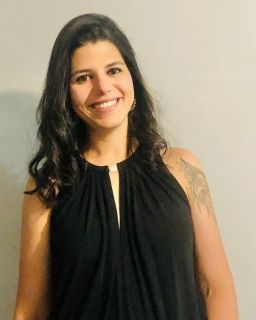Nathalia Dias
"Moving from Brazil to Canberra to study the Master of Archaeological and Evolutionary Science (Advanced) was one of the best decisions I've made."
By Evana Ho
In early 2018, Nathalia Dias made the move from Brazil to Canberra so she could study at the Australian National University. She came to begin a Master of Archaeological and Evolutionary Science (Advanced), and it was, she says, “one of the best decisions I've made”.
Nathalia was part of the first cohort of students to study the new degree. Back in Brazil, she had completed her undergraduate degree in archaeology and anthropology. She saw her future working in biological anthropology, and the Master of Archaeological and Evolutionary Science fulfilled that, along with filling gaps in her knowledge in archaeology.
“I learned a lot about scientific methods, about the different possibilities in archaeology – things I didn't know before,” Nathalia says. “But at the same time focusing on what I needed and what I wanted to do for my career.”
Australia was also enticing because she had found that archaeology and anthropology jobs are more highly paid here than in other parts of the world. And being a multicultural country, Nathalia felt she’d be able to adapt better to Australia than other countries she considered.
When she first moved to Canberra though, she found it a difficult transition coming from her bustling hometown: “At first it was such a shock for me, because Canberra is a quiet place.”
Now, the National Library of Australia, perhaps the quietest place in Canberra, is one of Nathalia’s favourite places in the world.
“I love it, I used to go there almost every day and spend hours there. I still miss the National Library so much!” Nathalia says.
In terms of her Masters degree, Nathalia says the most important thing about it is how complete it is. She had courses on social anthropology and the applications of social anthropology to archaeology. She learned more about carbon dating. Studied health and disease. It was both theoretical and practical, and Nathalia had been able to practice analysis in the scope of her courses – which she hadn’t been able to do back in Brazil.
“There is no other course in the world I think,” she says. “I think it's the only one with that combination.”
While choosing the Master of Archaeological and Evolutionary Science had brought her all the way to Australia, Nathalia wound up continuing the research she had begun in Brazil. With access to the ANU School of Archaeology and Anthropology laboratory in paleohistology – the only one of its kind in the southern hemisphere – she managed to conduct pioneering work on the earliest human remains in the Americas. The remains are some 11,000 years old, and they were discovered by archaeologists in Santana Do Riacho, about an hour from Nathalia’s hometown of Belo Horizonte.
“Through my thesis, I was trying to understand more about how physically active those people were. And how this would affect their bone microstructure,” Nathalia says. “I was lucky enough to find (Senior Lecturer) Dr Justyna Miszkiewicz to help me. She really supported me when I decided to do this thesis.”
The remains analysed were excavated from an early hunter-gatherer archaeological site, so the expectation was that they would have been using the most physically active type of subsistence strategy possible. But Nathalia’s research found that with the population from Santana Do Riacho, that wasn't the case.
She adds: “It was the first research ever on archaeological remains found in Brazil in histology. An amazing opportunity for me to continue my earlier research – and to do something that no one had done before.”
Nathalia completed her degree in December 2019. She returned to Brazil for a few months, and then in June landed a job with Terra Rosa Consulting in Perth. Her current project with them involves analysing human remains excavated from a section of East Perth Cemetery that will soon be developed. The idea is to build a biological profile of the remains, on characteristics such as sex, ancestry, and estimated age at death. That information will be provided to the National Trust.
When Nathalia applied for her job, the company were pleased with the combination of archaeology and biological anthropology that she had studied, and said it was important to them – especially for this project. Nathalia agrees that doing the Master of Archaeological and Evolutionary Science perfectly equipped her for her job, giving as an example the course ‘Ancient Health and Disease’.
“It's basically what I'm doing now for my job,” she says. “Everything that I learned there, I'm doing now. It is really interesting to see how the course taught me how to deal with the reality.”

